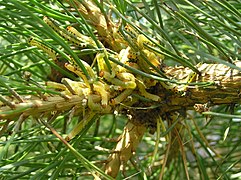
Sawflies are wasp-like insects that are in the suborder Symphyta within the order Hymenoptera, alongside ants, bees, and wasps. The common name comes from the saw-like appearance of the ovipositor, which the females use to cut into the plants where they lay their eggs. The name is associated especially with the Tenthredinoidea, by far the largest superfamily in the suborder, with about 7,000 known species; in the entire suborder, there are 8,000 described species in more than 800 genera. Symphyta is paraphyletic, consisting of several basal groups within the order Hymenoptera, each one rooted inside the previous group, ending with the Apocrita which are not sawflies.

The pine processionary is a moth of the subfamily Thaumetopoeinae in the family Notodontidae, known for the irritating hairs of its caterpillars, their processions, and the economic damage they cause in coniferous forests. The species was first described scientifically by Michael Denis and Ignaz Schiffermüller in 1775, though it was known to the ancients, with remedies described by Theophrastus, Dioscorides and Pliny the Elder. Its processionary behaviour was described in 1916 by the French entomologist Jean-Henri Fabre. It is one of the most destructive species to pines and cedars in Central Asia, North Africa and southern Europe.

Tent caterpillars are moderately sized caterpillars, or moth larvae, belonging to the genus Malacosoma in the family Lasiocampidae. Twenty-six species have been described, six of which occur in North America and the rest in Eurasia. Some species are considered to have subspecies as well. They are often considered pests for their habit of defoliating trees. They are among the most social of all caterpillars and exhibit many noteworthy behaviors.
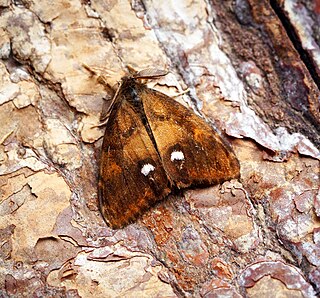
Orgyia antiqua, the rusty tussock moth or vapourer, is a moth in the family Erebidae.

Choristoneura fumiferana, the eastern spruce budworm, is a species of moth of the family Tortricidae native to the eastern United States and Canada. The caterpillars feed on the needles of spruce and fir trees. Eastern spruce budworm populations can experience significant oscillations, with large outbreaks sometimes resulting in wide scale tree mortality. The first recorded outbreaks of the spruce budworm in the United States occurred in about 1807, and since 1909 there have been waves of budworm outbreaks throughout the eastern United States and Canada. In Canada, the major outbreaks occurred in periods circa 1910–20, c. 1940–50, and c. 1970–80, each of which impacted millions of hectares of forest. Longer-term tree-ring studies suggest that spruce budworm outbreaks have been recurring approximately every three decades since the 16th century, and paleoecological studies suggest the spruce budworm has been breaking out in eastern North America for thousands of years.

Hyblaea puera, the teak defoliator, is a moth and cryptic species complex native to South Asia and South-east Asia. It was first described by Pieter Cramer in 1777. The species has also been recently reported to be present in Central America and Africa. The caterpillar feeds on teak and other trees. It is considered to be one of the major teak pests around the world.

Orgyia pseudotsugata, the Douglas-fir tussock moth, is a moth of the subfamily Lymantriinae first described by James Halliday McDunnough in 1921. It is found in western North America. Its population periodically irrupts in cyclical outbreaks. The caterpillars feed on the needles of Douglas fir, true fir, and spruce in summer, and moths are on the wing from July or August to November.

Cydalima perspectalis or the box tree moth is a species of moth of the family Crambidae, first described by Francis Walker, the English entomologist, in 1859. Native to Japan, China, Taiwan, Korea, far-east Russia and India, it has invaded Europe; first recorded in Germany in 2006, then Switzerland and the Netherlands in 2007, Great Britain in 2008, France and Austria in 2009, Hungary in 2011, then Romania, and Spain. It has been seen in Slovakia, Belgium and Croatia.

Lymantria dispar dispar or LDD moth, commonly known as the gypsy moth, European gypsy moth, North American gypsy moth, or spongy moth, is a species of moth in the family Erebidae that is of Eurasian origin. It has a range that extends over Europe, Africa, and North America.

The redheaded pine sawfly, European pine sawfly or Neodiprion sertifer, is a sawfly species in the genus Neodiprion. Native to Europe, it was accidentally introduced to North America in 1925, where it has established itself as a commercial pest.

Neodiprion abietis, commonly known as the balsam fir sawfly, is a species of insect in the family Diprionidae. It is found in North America from Canada to northern Mexico and is phytophagous, feeding on the needles of coniferous trees.

Hylastes ater is a species of beetle in the family Curculionidae, the true weevils. It is a bark beetle, a member of the subfamily Scolytinae. Its common name is the black pine bark beetle. It is native to Europe and parts of Asia, including China and Korea. It is known as an introduced species in many other regions, including Australia, New Zealand, the Americas, and South Africa. It is a pest of pines and other trees, and it is widespread in areas where pine trees are cultivated. The species "is an important threat to the biosecurity of all forested countries."
Hoplocampa testudinea, the apple sawfly or European apple sawfly, is a species of sawfly in the family Tenthredinidae. It is native to Europe but has been accidentally introduced into North America where it became invasive. The larvae feed inside the developing fruits of the apple tree.

Diprion similis is a species of sawfly in the family Diprionidae. It is native to central and northern Europe and Asia but was accidentally introduced into North America where it has become invasive. The larvae feed on the needles of pine trees, especially those of the white pine. In North America it is known as the introduced pine sawfly or the imported pine sawfly. It is also known as the white pine sawfly because of its preference for feeding on the white pine, but this name is confusing because another sawfly, Neodiprion pinetum, whose larvae also feed on this tree, is itself known as the "white pine sawfly".
Neodiprion pinetum is a species of sawfly in the family Diprionidae. It is commonly known as the white pine sawfly, a name sometimes also applied to Diprion similis, because the larvae of both species feed on the needles of the white pine.
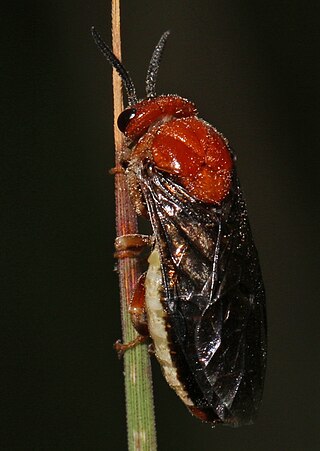
Neodiprion lecontei is a species of sawfly in the family Diprionidae native to eastern North America, commonly known as the red-headed pine sawfly or Leconte's sawfly. The larvae feed on the foliage of many species of native and imported pines. This species was named after John Lawrence LeConte, an American entomologist of the 19th century.
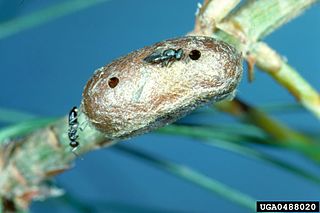
Dahlbominus fuscipennis, the sawfly parasitic wasp, is a species of chalcid wasp from the family Eulophidae which parasitizes the European pine sawfly Neodiprion sertifer, among other hosts. It is the only species in the genus Dahlbominus.

Acantholyda erythrocephala is a species of sawfly in the family Pamphiliidae commonly known as the red-headed pine sawfly or the pine false webworm. Native to Europe, it has been introduced into North America where it has become invasive.
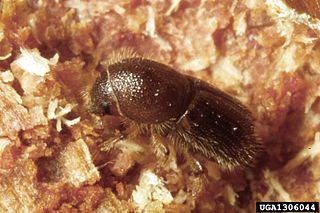
Ips pini, also known as the pine engraver or North American pine engraver, is a species of typical bark beetle in the family Curculionidae that exists primarily in North America. Among the broadly distributed species across the entirety of North America, populations of these beetles are further broken down into distinctive geographical ranges with a distinctive feature of how the groups produce the enantiomeric composition of ipsdienol—the major pheromone component produced by males.
Lathrolestes luteolator is a species of wasp in the family Ichneumonidae. it is native to North America and is a parasitoid of various species of sawfly larvae. In the 1990s, it started to parasitise the larvae of the invasive amber-marked birch leaf miner in Alberta. When this pest spread to Alaska, the wasp was used in biological pest control.






